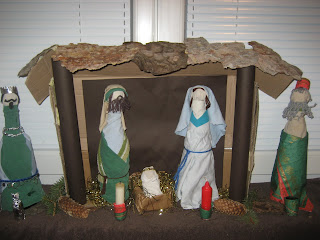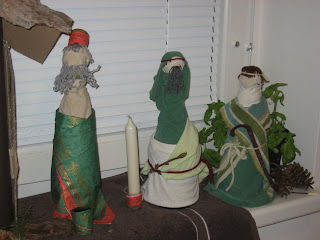A good student of theology knows the sacred languages! By this standard, I am far from a "good" student, but I am trying to work hard at it, because I think it's important.
To that end, I have found an ingenious app (FREE!) for training on basic ecclesiastical vocab in Greek, Hebrew, and Latin! Even better, the app is optimized for the iPad, which I like very much.
The app is called iDoms Vocab, and seems to be a joint project between the Irish Province of Dominicans and the St. Joseph's Province in the USA. They have another app, called the iDoms Reader, which I haven't downloaded but looks like a news app of sorts.
The app works well! It is a very new app, only released a few days ago, but it has good navigability, and is a clever way of improving on the old handwritten flash cards, building in a nice scorekeeping feature to make it a little more fun. The ingenuity in the app lies in the repetition and introduction of new words. Each time you start a session, it gives you 30 words to do, so it only takes a few minutes. As you learn words consistently enough, the program replaces the words you have mastered with new words automatically. Go through the flash cards a few times a day, and you'll expand your vocabulary immensely! Because the app is so new, the word bank is limited, but they have intentions of expanding.
A clever integration of the Apple iCloud technology helps for those who have on-the-go lives. For those of you who don't speak Apple, that means that if you have an iPhone and an iPad with the app installed on both, whatever progress you have made on one of them, you can continue on the other, working seamlessly between the two.
Overall, a very impressive little app! It should be noted that it is only for memorization of vocab, and doesn't help with learning and memorizing declensions and cases-- a feature that, if they were able to figure out a good means of integrating, would be priceless for us students.
Some more pictures:
Your language options-- it comes with a free sample Greek vocab list, but then you can buy other word banks through their in-app store using your appleID. I downloaded their Latin word bank with words from the Prima Pars of the Summa for only $0.99.
A new word, "sicut," as in "sicut cervus ad fontes". You can choose "I know!," which skips immediately to the next word, or "Don't Know" or "View," which displays the translation.
What it displays once you click "View". You can then say that I got this one "Right", or "Wrong," which helps with the programs' ability to track your progress and create future study sessions.
Overall, a really great app, and many kudos to the Dominicans who came up with this app-- I know that it is going to help me out immensely this term.
Sunday, January 15, 2012
Thursday, January 12, 2012
In the Spirit of "Christmas Isn't Over Yet"...
Though many families have already bid farewell to their Christmas tree, holiday decorations, baked goodies (not a moment too soon for the pursuit of that ever elusive slender figure), and Nativity scenes, our household belongs to that variety of Catholic who obstinately refuses to relinquish our Christmas festivities until Candlemas, the traditional end of the Christmas season. Be the tree completely needle-less, be the Christmas cookies completely consumed, be the stores filled with Valentine's Day sweets, we persist in our Christmas celebration.
This was the first Christmas our little family has spent on our own - and as such, we found ourselves in need of Christmas decorations to suit our budget. Our aim for decorating was to make as many of our decorations as possible, using for the most part items we either had around the house or could easily collect. I began my planning and collecting back in November, stashing away these items in the weeks before and during Advent:
Beer and Irish cream bottles
Pinecones
Fallen pine tree bark
Platan seed clusters (they're slightly smaller than a golf ball)
Twigs
Cardboard boxes
Toilet paper rolls
Used tissue paper
Christmas napkins
Rags/worn clothing of all sorts
Candles (leftover from our Advent wreath)
Old jewelry
Stray ribbon and yarn
Used (but reasonably clean) aluminum foil
Brown construction paper
And what can one assemble with all these miscellaneous items, you may ask?
A beer bottle Nativity scene!
(with a dried fruit, pinecone and popcorn garland and crocheted Star of Bethlehem)
Each figure (the Baby Jesus excepted) is a beer (or Irish cream) bottle, with a platan seed head covered in fabric. I dyed a few rags using coffee grounds and tea bags for the heads, used some spare yarn for hair, and rags and other odds and ends for the clothing.
The cardboard served as a base for the stable, with pinecones and bark used to create a "natural" effect. Here are some close-ups:
I believe a "recycled" Nativity scene just may become a family tradition - especially when our children are old enough to participate in annual Nativity figure "makeovers". I already have plans for next year's additions: some animals, a new and improved stable, and possibly some more majestic clothing for the Three Kings.
Our beer bottle Nativity (barring any unforeseen accidents) will see us through Candlemas, in keeping with the longstanding tradition of displaying the creche until the end of the forty days of Christmas.
However, if your Christmas decorations have already been packed away, do not despair. It's never too early to start your Christmas 2012 recycling! If you've been bitten by the Martha Stewart bug, to increase the variety of your project, and considering the wealth of items that are often simply thrown away in the post-Christmas cleaning, I would recommend starting a little "crafts bin" now: a storage place for all the odds and ends that may come in handy for your own beer bottle Nativity, or other projects to celebrate the liturgical year.
Subscribe to:
Posts (Atom)








